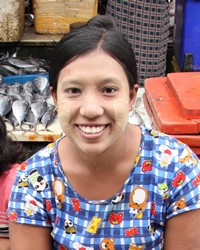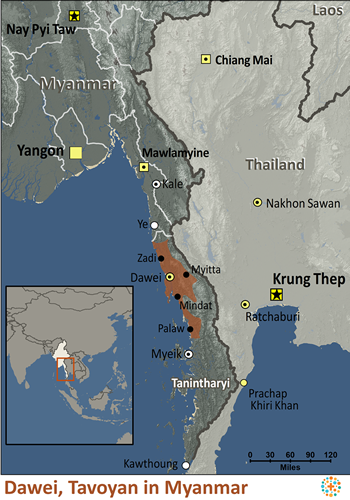Over a century ago, the Dawei were considered close relatives of the Rakhine people on the other side of the country, with one source describing them as "the descendants of original Rakhine settlers who speak a dialect of Rakhine with a slight admixture of Thai." In 1931, the census found there were 156,507 Dawei people in Myanmar, all of whom were Buddhists except a mere 78 Christians.
Location: With a population approaching half a million people, the Dawei ethnic group inhabits the northern Tanintharyi Region in southeast Myanmar. They occupy a long, narrow strip of land that separates the Andaman Sea from the Gulf of Thailand in an area containing beautiful golden beaches and lush mountains. The city of Dawei was formerly known as Tavoy, and the people were called Tavoyan during the British colonial era. With Dawei located 381 miles (614 km) from Yangon, the people have a sense of separation, and only recently has the area been connected to the rest of the country by road and rail. Dawei communities spill over into neighboring Mon State, while about 600 Dawei have crossed the border and now dwell in Thailand, where they fled to escape oppression by the Burmese military in the mid-1990s. Even after arriving in Thailand, one group of Dawei refugees was reportedly attacked by a battalion of Myanmar's 62nd Infantry.
Language: Although Dawei is often considered a dialect of Burmese, their language contains “profound pronunciation and vocabulary differences from Burmese.” Another source notes that the Dawei language “has many loan words from Malay and Thai not found in Standard Burmese. Terms of endearment, as well as family terms, are considerably different from Burmese.
Over the centuries, Dawei has been part of many kingdoms as regional powers rose and fell. From the 11th to the 13th centuries Dawei was part of the Bagan empire before being incorporated into the Sukhotai kingdom from 1287 to 1564, and then into the Ayutthaya kingdom of today's Thailand, which ruled the area intermittently until the mid-18th century. To this day, the Dawei call Burmese people “gantha,” meaning “children of Bagan.” In the mid-1990s, more than 15,000 Dawei civilians were forced to work on the construction of the Ye to Dawei railway, which was not constructed for tourism or trade, but to help the Burmese military rapidly deploy troops to the border areas.” A new proposed highway and railroad across the Tenasserim mountains from Dawei to Thailand and the planned construction of a deep-water port will potentially connect the Dawei people to the world for the first time.
As early as 1587, the Dawei region was one of the main producers of tin in Asia, most of which was exported to India. Today the main products of Dawei include rubber, teakwood, fish, pineapples, mangoes, and cashew nuts. One way the Dawei people differentiate themselves from the Burmese is through their unique cuisine, which includes a fruit called zin that grows only in their area. The monsoon season between May and September each year often floods Dawei with over 50 inches (127 cm) of rainfall in most months making it one of the wettest tropical areas in the world.
From the earliest recorded accounts, the Dawei people have been devoted Theravada Buddhists. Even the name “Dawei” is a Mon word meaning “to sit cross-legged” in reference to the Buddha's posture. The Dawei area contains hundreds of Buddhist temples, monasteries, and pagodas, and few Dawei people see any need to change the religion that forms the backbone of their ethnic and cultural identity.
Although American Baptist missionaries served in Dawei for decades, and even opened a seminary in the city in 1836, their focus was always on reaching the Karen people, and very few Dawei were targeted with the Gospel. As a result, the Dawei remain one of the least evangelized people groups in Myanmar today, with less than one in every 1,000 people professing faith in Jesus Christ. The Dawei New Testament was published in 2024, giving hope for a breakthrough among this large unreached group.
Scripture Prayers for the Dawei, Tavoyan in Myanmar (Burma).
| Profile Source: Asia Harvest |

























